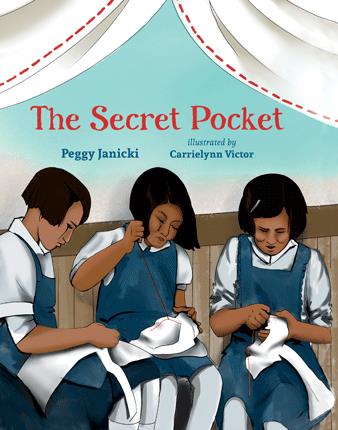| Secret pocket Author: Janicki, Peggy | ||
| Price: $25.86 | ||
Summary:
This nonfiction picture book tells the true story of how a group of girls at a residential school sewed secret pockets into their clothes to hide food.
| Illustrator: | Victor, Carrielynn |
Reviews:
Kirkus Reviews (05/01/23)
School Library Journal (+) (06/01/23)
Booklist (04/01/23)
Full Text Reviews:
Booklist - 04/01/2023 Janicki, a teacher from the Nak’azdli Whut’en First Nation in British Columbia, offers a family story told by Mary, her mother, recalling her experiences after a priest and a nun persuaded her parents to let them take her, a four-year-old, along with her older brother and sister, to live at the Lejac Residential School. She seldom saw her brother there, as boys and girls were kept apart, and rules were strictly enforced with a leather strap. She was always cold, hungry, and homesick. An older girl taught her to eat toothpaste to quell her hunger pains. Later, she and other girls sewed secret pockets into their clothing, enabling them to hide food swiped from the kitchen and share it with the younger children. As an elderly woman, she took pride in the courage and traditional skills that enabled the students to survive. Rooted in personal experience, the storytelling is plainspoken and involving. Victor, descended from Coast Salish ancestors, contributes a series of simply drawn, expressive illustrations. A moving picture book. - Copyright 2023 Booklist.
School Library Journal - 06/01/2023 Gr 1–3—A first-person viewpoint gives this story an immediacy that captures the sympathy of readers and holds their attention. The author describes her mother's experiences at a residential school for Indigenous children in Canada and how she used skills learned from her family to survive. Conditions are described in a matter-of-fact tone, which only underscores the appalling way the children were treated. The color palettes change to contrast the setting at school to that at home. Bare walls, wooden floors, and dull uniforms reflect the bleak circumstances the children are trapped in during the school year, while the time at home is shown in green, gold, pink, and red. Descriptions of all the food the family gathers and prepares are jarringly different from the "mush…gray soup" and "meat…often rotten" that make up the meals at school. But the girls use traditional sewing skills to create secret pockets in which they can smuggle food out of the kitchen and share it with others to ensure their survival. A glossary and author's note support reader comprehension and explain the author's personal connection to the events portrayed. Pair this with Carole Lindstrom's uplifting My Powerful Hair, another redemptive family story from this era. VERDICT An age-appropriate telling by an Indigenous creative team of a tragic historical period.—Suzanne Costner - Copyright 2023 Publishers Weekly, Library Journal and/or School Library Journal used with permission.



